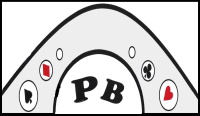What should we know first?
We are dealing here with the second bid made by responder. This means that Opener will have bid twice and responder once, by the time we reach this position. It is important that you know what these first 3 bids mean.
OPENING BID
- 1 of a suit – 12-19 points, 4 card suit
- 1NT – 12-14, balanced
- 2 Clubs – 23+ or game making
- 2NT 20-22, balanced
- 2 or more of a suit – pre-emptive, weak with a long suit
1ST RESPONSE
- Raise openers suit – shows point count and fit
- Bid new suit at 1 level – 6+ points and 4 card suit
- Bid new suit at 2 level – 10+ points and 4 card suit (unless 1♠, 2♥)
- 1NT if partner opens a suit – 6-9 and no support for partner
If partner opens NT then the next few moves should be easily dictated by NT conventions.
OPENERS 2ND BID
- Repeat opening suit at 2 level – 5 card suit and 12-15 points
- Repeat opening suit at 3 level – 5 card suit and 16+ points
- New suit below barrier – 5,4 shape and 12-15 points
- New suit above barrier – 5,4 shape and 16+ points
- NT rebids show balanced hands with more than 14 points
- Raise of responders suit to 2 level – support and 12-15 points
- Raise of responders suit to 3 level – support and 16-18 points
- Raise responders suit to 4 level – support and 19+ points
For now we will focus on auctions where opener has opened 1 of a suit and rebid in a suit.
Think about what you know!
By this point in the auction partner has bid twice. You should therefor have a decent idea of what their hand is like. Make sure that you take the time to look at partners bids and think about what they mean.
If You Find a Fit With Partner
Think about your and your partner’s hands together.
Do you have a suit fit with partner? Is your hand strong enough to raise the suit, invite to game or should you just pass?
Finding Your Fit
Remember that if partner has bid two suits then they are showing at least 5 cards in the first suit and 4 in the second. If they bid a suit twice then they must have at least 5 in that suit.
If you find a major suit fit with partner, or if you have a good minor suit fit and a hand unsuitable for NT then you need to bid your support at the appropriate level for your points.
Counting Your Points
Look how many points partner has shown. They will usually indicate either a weak hand (12-15), or a strong one (16-19).
Count your own points. REMEMBER TO INCLUDE FIT POINTS. If partner is maximum for their range will you have enough for game? If not then pass if the active suit is the one you wish to support. If not rebid your suit at the lowest level.
If you will definitely have enough points for game even if partner is minimum then bid the game!
If you are in between then make an invitational 3 level bid.
MAKE SURE YOU BID THE MAXIMUM VALUE OF YOUR HAND!
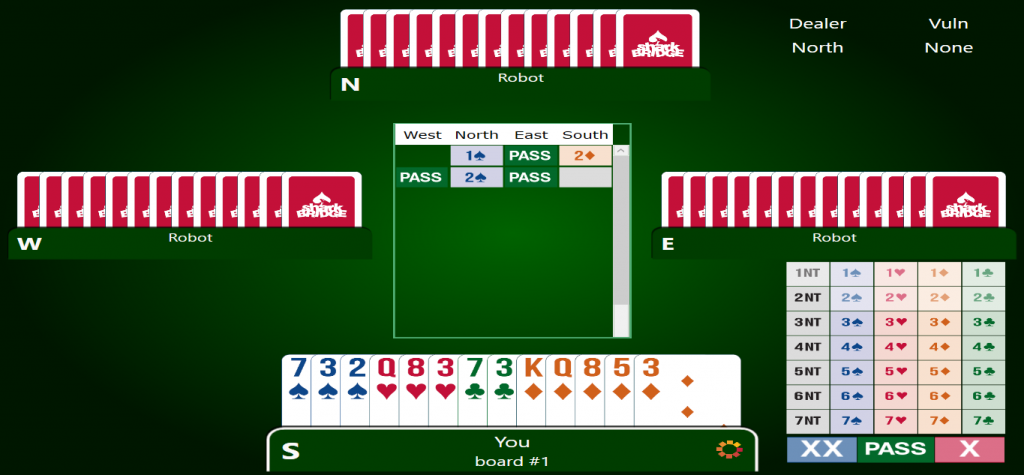
It is your turn to bid in the South seat. Partner has opened 1♠ and rebid 2♠. They are showing a hand with a 5 card spade suit and 12-15 points.
You know that you do not have points for game. You do just about have a spade fit. The best move here then is to pass and let partner play in 2♠.
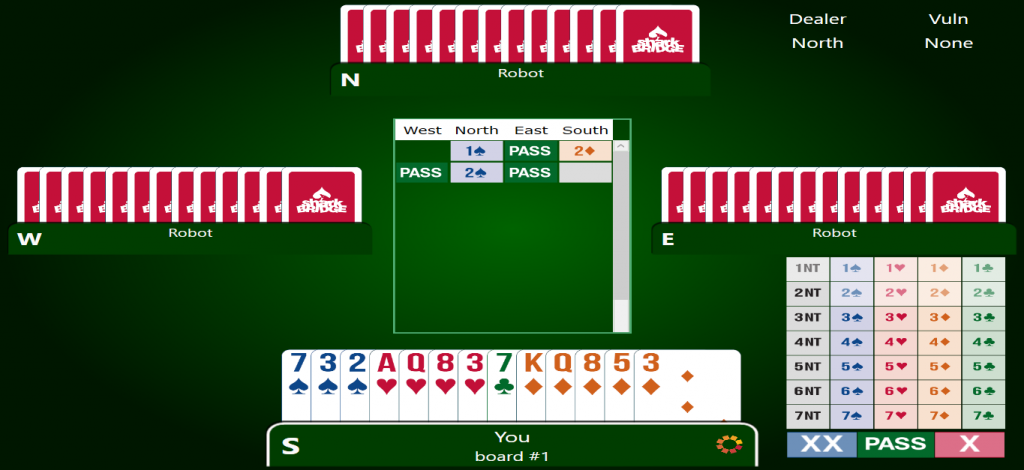
It is your turn to bid in the South seat. Partner has opened 1♠ and rebid 2♠. They are showing a hand with a 5 card spade suit and 12-15 points.
This time you have a better hand. 11 HCP plus 3 fit points for a total value of 14. Even if partner has the minimum 12 you have enough for game.
You should bid straight to 4♠.
Bidding With No Support For Partner
NT as a Second Response
If you cannot support your partner in a suit, and you do not need to show another suit of your own then you will often bid NT at this point.
This means roughly THE SAME AS IT WOULD AS A FIRST RESPONSE!
So if partner opens 1♥ and you bid 1NT it shows 6-9 points and no support.
If the auction goes 1♦-1♥-1♠-1NT then the 1NT still shows 6-9 points and no support.
Note that in auctions like this you cannot bid a second suit as responder as this would involve bidding all 4 suits – a forcing move (see more below)!
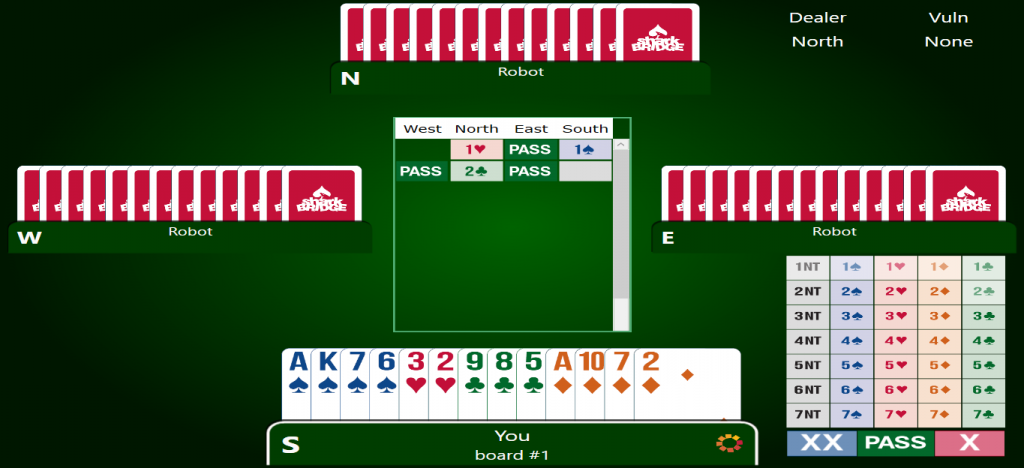
It is your turn to bid in the South seat. Partner has opened 1♥ and rebid 2♣. This shows 5 hearts, 4 clubs and 12-15 points.
You cannot support partner or bid a suit. 2NT shows this and also shows 10-12 points.
Responder’s Barrier
If you can keep describing your hand by bidding another suit (often when partner has bid their suit twice) then you will need to keep an eye on your barrier!
Responder is in much the same position as opener, in that they have their own barrier and their second bid should be dictated by the shape of the hand and whether you can bid through the barrier.
Responder’s barrier does not work in quite the same way as opener, but the basic concept is the same.
When you open 1 of a suit, your barrier is set at 2 of that suit. If you bid beyond that barrier with your second bid you are showing a strong hand (16+ points).
As responder, your barrier is set 1 level higher than your first response. So if you respond 1 spade to partners opener then your responder barrier is set at 2 spades.
Instead of a set distinction between strong and weak hands, breaking the responding barrier shows ENOUGH POINTS FOR GAME. The amount of points needed for this will depend on the kind of hand opener has shown.
If opener has shown a normal 12-15 point hand then responder will need 13 points to break the barrier.
If opener has shown 16+ then responder only needs 9 points to force to game.
This is why it is vital to keep an eye on what partner is telling you about their point count.
If responder has the chance to bid 2 suits then this will show the same (at least ) 5,4 shape as when opener bids a second suit.
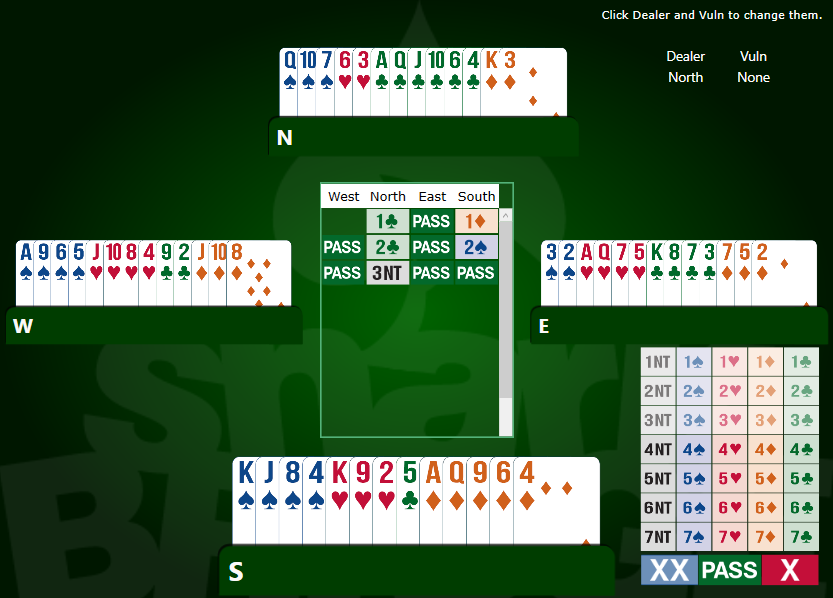
On this hand North opens 1 club. South’s longest suit is diamonds so their first response is 1 diamond. This sets the responder barrier at 2 diamonds.
North has no second suit to show. Rebidding 2 clubs shows a hand with at least 5 clubs and 12-15 points.
South knows that they have game points here. They can show this by bidding 2 spades. 2 spades is above 2 diamonds so it shows game points and a hand with at least 5 diamonds and 4 spades.
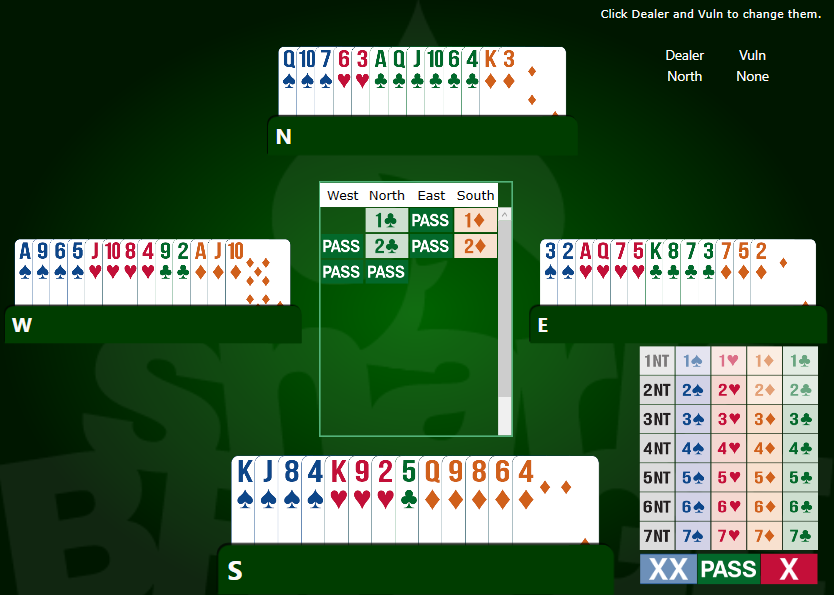
On this hand the auction begins the same way. This time though South does not have game points. By the time they get to their second response they must bid above 2 clubs. This means that they cannot show the spade suit without bidding above their responder barrier. They can only repeat the diamonds. With a weak hand themselves North should pass.
Fourth Suit Forcing
It is a common convention in bridge that bidding all 4 suits in the first 2 rounds of bidding is forcing to game.
You and your partner can agree various tweaks on this system, but to start I suggest this methos to keep things simple.
BIDDING THE FOURTH SUIT SHOWS
- a game forcing hand
- No 6 card suit to rebid
- No biddable fit for partner
- No cover in the 4th suit (if you have this you should bid NT)
TAKE NOTE – this does not promise length in the suit bid. This makes a 4th suit forcing bid both forcing and ARTIFICIAL.
Mostly what this does is ask partner for more information about their hand.
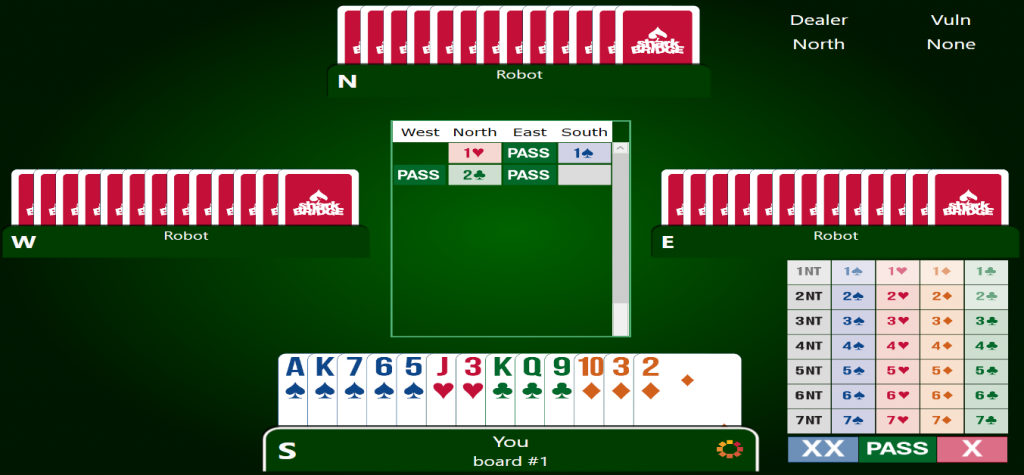
It is your turn to bid in the South seat. Partner has opened 1♥ and rebid 2♣. This shows 5 hearts, 4 clubs and 12-15 points.
With 14 HCP you know that you have game values. However, you cannot support either of partners suits.
You dont want to bid NT with no diamond cover, and you cannot rebid your spades AND show your points.
Bidding 2♦ here is fourth suit forcing. It is asking partner to tell you more.
Responding to 4th Suit Forcing
If partner bids the fourth suit then you have a set list of priorities
- If partner bid a major as a first response then show 3 card support for that major if you have it.
- If you have a longer suit than you have shown in the bidding thus far then rebid it.
- If you have cover in the 4th suit then bid 3NT.
